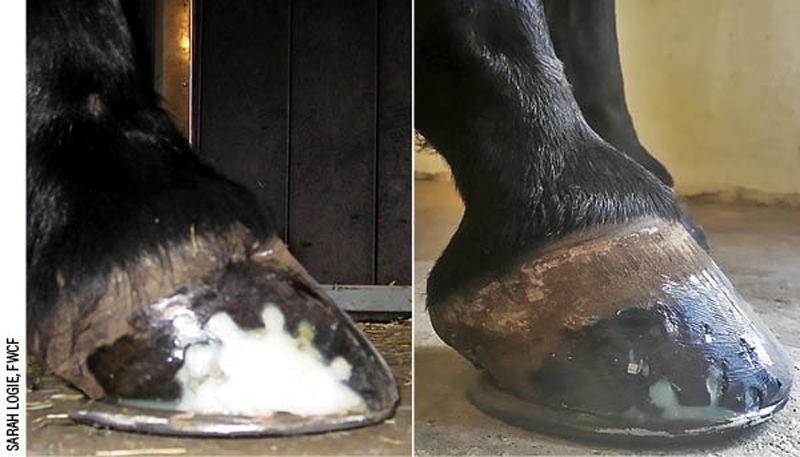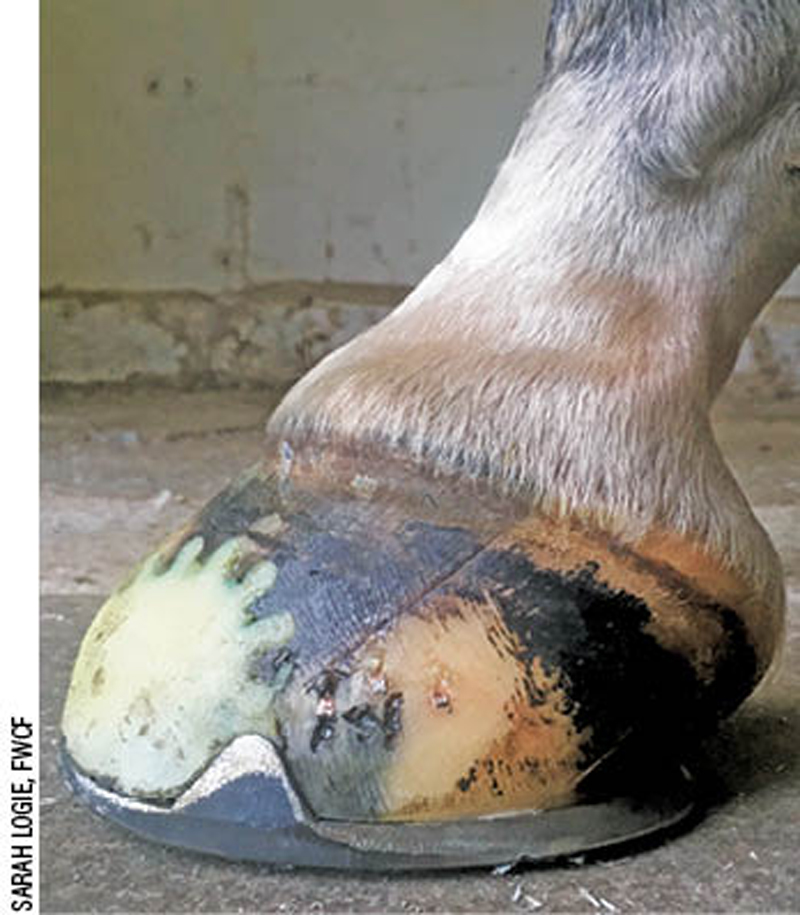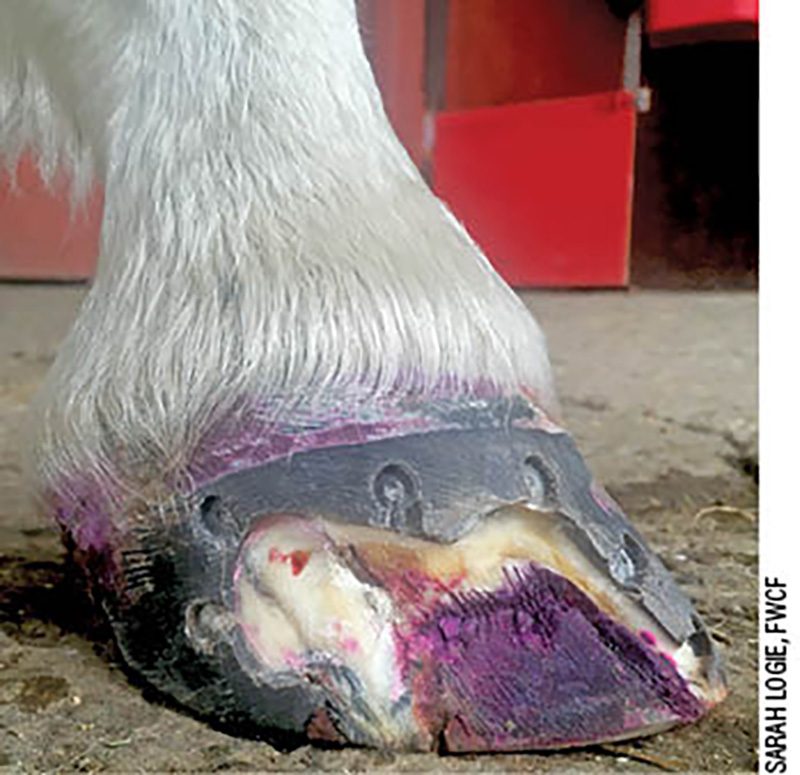Takeaways
- Keratinolytic disease of the zona alba (KDZA) is a common hoof ailment with a positive prognosis when it’s treated appropriately with underlying environmental conditions and systemic influencers brought under control. Prevention, treatment and management hinge upon whether KDZA is determined to be Type 1 or Type 2 — with Type 1 being the more straightforward subtype to address.
- Hoof resection is critical in more advanced cases of KDZA to debride the hoof and expose the infected area to the topical treatment. A medicated patch and proper shoeing support the hoof throughout the healing process. If the horse is sound and undergoing proper management, it often continues a normal workload during the treatment process.
Keratinolytic disease of the zona alba (KDZA), commonly known as white line disease, is a hoof pathology present across a wide range of breeds and disciplines. Referred to previously as hollow wall or seedy toe — as well as by various other descriptors — KDZA emerged as the most clinically correct term for the pathology when it was introduced in 2018 by fourth-generation farrier and author Simon Curtis, PhD, FWCF (Hons), HonAssocRVCS, of Newmarket, England.
White line disease has been the widely accepted term to describe a recognizable separation in the hoof wall in which keratinolytic pathogens have invaded since the 1990s, says Sarah Logie, FWCF. However, the Inverness, Scotland-based farrier cautions that terms like seedy toe and white line disease are often misleading.
“Both descriptions involve the growth of the same anaerobic bacteria and subsequent invasion by keratinophilic fungal spores, but these invasions extend beyond the most proximal aspect of the white line,” Logie explains. “This means the term ‘white line disease’ is inaccurate because when the infection is in the unpigmented horn of the stratum medium, it can spread to the coronary band. That’s not the white line — it’s just where we tend to first see it.”
KDZA is the first accurate term used to describe this commonly encountered hoof ailment, Logie says.
“It truly says what it is — a disease affecting the non-pigmented portion of the stratum medium, or zona alba, where the horn cells are digested by keratinolytic pathogens,” she says. “All these different terms are recognized as the same condition, but to use an inaccurate one for the sake of tradition seems pointless.”

A patch, when correctly applied, mimics the healthy hoof capsule and can help the horse return to a normal workload during the treatment period.

Radiographs help reveal the extent of the KDZA infection of the hoof wall.
Tell-Tale Signs: Identifying KDZA
KDZA is characterized by the damage and subsequent separation of the stratum medium from the stratum internum, Logie says.
“This separation may be recognized as a small to large separation anywhere in the white line where dirt is packed in, or in the shod foot where the cavity is filled with a foul-smelling black mush and cheesy, crumbling horn matter,” she explains. “The wall itself may bulge when viewed on the ground. In severe cases, lameness may occur as P3 becomes destabilized. In other cases, horses may have poor hoof quality with all four hooves having issues throughout the white line.”
In all cases, Logie says the pioneer organisms are anaerobic, sulfur-reducing bacteria that destroy the sulfur bonds between the keratin molecules. This destruction opens the door for opportunistic keratinophilic fungus and bacteria to infiltrate and digest the elements of the keratin, thereby leaving the hoof wall weakened or absent.
Farriers can safely cover the area, knowing that bacteria won’t survive under a medicated patch …
Understanding the Subtypes
KDZA is grouped into two subtypes — Type 1, known as structural; and Type 2, known as systemic.
“In Type 1 KDZA, an insult or weakness occurs in the hoof through a fundamentally isolated mechanical cause,” she says. “Cracks, a nail hole, or an area of gravel pushing into the soft white line can cause a separation. Horses suffering from this may have recognizable healthy horn in all other parts of the affected hoof and may only have one affected hoof. The isolated area will be obvious and if untreated may spread as sulphur-reducing bacteria weaken the horn structure, allowing fungal species to enlarge the cavity.”
In Type 2 KDZA, Logie says the signs often point to an environmental or systemic cause.
“These horses are observed to have generally poor hoof quality with brittle outer layers of horn and signs of blackening around the nail holes or around the white line in general,” Logie explains. “They may not retain shoes well or may not withstand being without shoes. They may be lame or hoof sore, and they may also experience chronic laminitis.”

Four shoeing cycles and 141 days were necessary to grow out this horse’s hoof wall since treatment began for KDZA. The horse has been sound since the first treatment. Glue was added to fill the drill holes as the area grew out.
Preventing KDZA
Prevention varies depending on whether the origin is structural or systemic. Because of this, Logie says the root causes of a horse’s KDZA must be identified.
“In Type 1 cases, incorrect hoof balance and over-dressing of the dorsal wall is one of the major causes of KDZA,” she says. “Incorrect landing and loading of the hoof capsule create strain on the hoof wall, thereby allowing something as seemingly benign as a nail hole or crack allow bacteria the opportunity to enter the hoof. Ensuring even loading of the hoof wall and as true limb movement as possible to avoid torque in the hoof, while preserving hoof wall structure and thickness, is the best prevention in these cases.”
In Type 2 cases, Logie cautions that multiple factors, including environment and nutrition, may be at play.
“Type 2 cases may improve when the environment changes,” she says. “Maintaining dry and clean conditions underfoot, although difficult, is one of the best things for these horses. Although environmental factors affect all feet in an individual horse, they do not affect all horses — there must be some underlying weakness in the affected individual.”
In addition to environmental conditions, nutritional deficiencies may play a key role in keeping KDZA at bay.
Using an inaccurate term for the sake of tradition seems pointless …
“Nutrition plays a major role in the occurrence of Type 2’s weak feat,” Logie explains. “If the horn being produced is of poor quality and strength, opportunistic organisms can rapidly invade and digest the innermost layers of horn, leaving the outside layers to collapse — particularly if they’re already compromised by environmental conditions.”
Logie advises farriers to identify and be aware of less-than-optimal conditions that may adversely affect the horse’s hoof quality.
“Being aware of any systemic weaknesses or environmental challenges allows the farrier to trim or shoe appropriately,” she says. “The owner should also tailor the management to give the hooves the best nutrition, hygiene and environment possible.”
Hoof Resection & Disease Management
Much like thrush, KDZA is a common and largely treatable hoof ailment. Resection is the go-to course of treatment in both structural and systemic cases, with the foremost goal of resection being to expose the affected area to air.
“Type 1 cases are very straightforward to treat,” Logie assures. “The area should be debrided back to solid, sound horn. Small areas may not require resection, but larger areas where the margins of the cavity cannot be observed should be fully resected.”
As the initial bacteria are anaerobic, the traditional treatment was to expose the area to the air and keep it clean. However, Logie’s study about KDZA reveals that heavy reliance on management and environment often meant the area showed further infection when reexamined at the next shoeing.
“By adding a medicated patch, the farrier can ensure they can safely cover the area, knowing that any further bacteria will not survive in the environment under the patch,” she explains. “On the other hand, a patch with a non-effective treatment is just as bad as ignoring the initial infection and may worsen the condition.”
Once the area has been debrided, Logie says she prefers a copper sulfate powder under Imprint thermoplastic material but acknowledges that other adhesives also have been proven effective.

A patch applied to the hoof wall and stabilized with a heart-bar shoe and sole pack can help restore a horse to soundness while KDZA is managed.
“The goal is to remove the damaged and infected horn, prevent reinfection in case of any bacteria working their way in or left behind, and return structural strength to the hoof capsule with the patch — which also keeps the area clean,” she explains.
In milder cases not requiring resection, Logie recommends the area be packed with copper sulfate and a hoof putty or clay.
“Copper sulfate must not be used on any area where sensitive tissue has been exposed,” she cautions. “Even the smallest pinprick of blood must be excluded with a hoof putty, or treatment delayed for a couple of days until it has keratinized and not sensitive because it will burn sensitive tissue.”
LEARN MORE
Gain more insight from Sarah Logie’s research by visiting AmericanFarriers.com/0324
Although Type 1 cases are relatively straightforward in treatment protocol, Logie says Type 2 cases, which may have environmental or nutritional influencers, are more complex.
“These cases are harder to treat because it varies depending on the individual case,” Logie says. “If the underlying cause is brought under control, normally the feet improve as a side effect. Farriery alone will not solve these cases.”
The implications of untreated KDZA can be far-reaching.
“Complications can range from the inconvenience of hooves never being solid, awkward to nail to, and shoe loss to lameness and laminitis due to loss of attachment from P3 to the hoof wall,” she says. “It’s a condition that will not resolve without a proactive hoof management approach and appropriate management.”









Post a comment
Report Abusive Comment